PUBH6007: Public Health Needs Assessment of Youth Obesity in Melton
VerifiedAdded on 2023/04/20
|8
|1995
|309
Report
AI Summary
This report presents a comprehensive needs assessment of school-going youth in the City of Melton, Australia, who are categorized as overweight or obese. It identifies various needs, including normative, expressed, comparative, and felt needs, and prioritizes them based on criteria such as cost-benefit ratio, feasibility, and impact. The assessment highlights issues like the lack of strict government policies, poor school structure, inadequate parental guidance, and high availability of unhealthy foods. The report also discusses potential barriers to the proposed program, such as cultural differences and funding limitations, and includes a SWOT analysis to evaluate the program's strengths, weaknesses, opportunities, and threats. Ultimately, the proposed plan aims to formulate a community-engaging action plan to address the identified issues and reduce the prevalence of obesity among youth in Melton, contributing to improved long-term health outcomes and reduced healthcare expenditure.
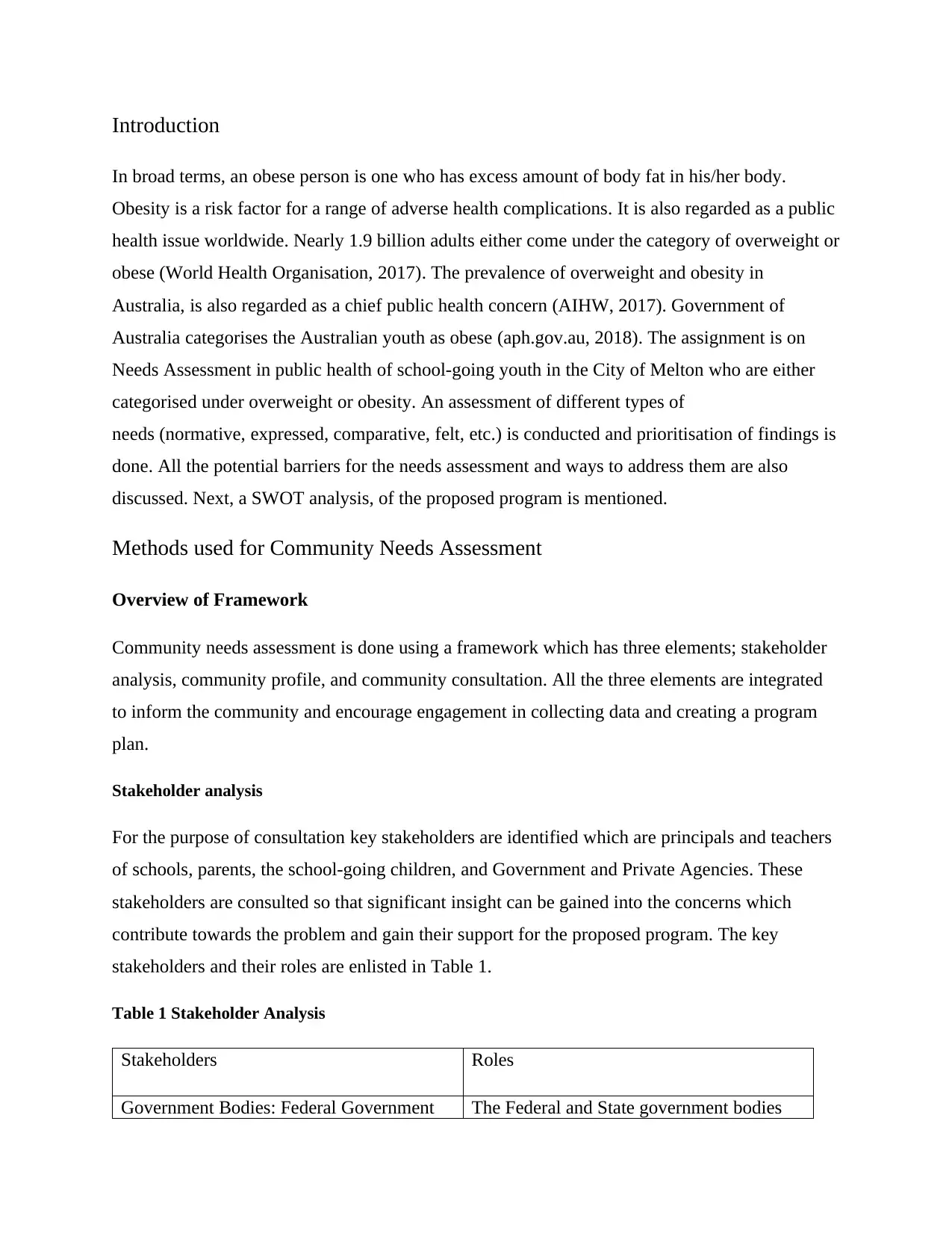
Introduction
In broad terms, an obese person is one who has excess amount of body fat in his/her body.
Obesity is a risk factor for a range of adverse health complications. It is also regarded as a public
health issue worldwide. Nearly 1.9 billion adults either come under the category of overweight or
obese (World Health Organisation, 2017). The prevalence of overweight and obesity in
Australia, is also regarded as a chief public health concern (AIHW, 2017). Government of
Australia categorises the Australian youth as obese (aph.gov.au, 2018). The assignment is on
Needs Assessment in public health of school-going youth in the City of Melton who are either
categorised under overweight or obesity. An assessment of different types of
needs (normative, expressed, comparative, felt, etc.) is conducted and prioritisation of findings is
done. All the potential barriers for the needs assessment and ways to address them are also
discussed. Next, a SWOT analysis, of the proposed program is mentioned.
Methods used for Community Needs Assessment
Overview of Framework
Community needs assessment is done using a framework which has three elements; stakeholder
analysis, community profile, and community consultation. All the three elements are integrated
to inform the community and encourage engagement in collecting data and creating a program
plan.
Stakeholder analysis
For the purpose of consultation key stakeholders are identified which are principals and teachers
of schools, parents, the school-going children, and Government and Private Agencies. These
stakeholders are consulted so that significant insight can be gained into the concerns which
contribute towards the problem and gain their support for the proposed program. The key
stakeholders and their roles are enlisted in Table 1.
Table 1 Stakeholder Analysis
Stakeholders Roles
Government Bodies: Federal Government The Federal and State government bodies
In broad terms, an obese person is one who has excess amount of body fat in his/her body.
Obesity is a risk factor for a range of adverse health complications. It is also regarded as a public
health issue worldwide. Nearly 1.9 billion adults either come under the category of overweight or
obese (World Health Organisation, 2017). The prevalence of overweight and obesity in
Australia, is also regarded as a chief public health concern (AIHW, 2017). Government of
Australia categorises the Australian youth as obese (aph.gov.au, 2018). The assignment is on
Needs Assessment in public health of school-going youth in the City of Melton who are either
categorised under overweight or obesity. An assessment of different types of
needs (normative, expressed, comparative, felt, etc.) is conducted and prioritisation of findings is
done. All the potential barriers for the needs assessment and ways to address them are also
discussed. Next, a SWOT analysis, of the proposed program is mentioned.
Methods used for Community Needs Assessment
Overview of Framework
Community needs assessment is done using a framework which has three elements; stakeholder
analysis, community profile, and community consultation. All the three elements are integrated
to inform the community and encourage engagement in collecting data and creating a program
plan.
Stakeholder analysis
For the purpose of consultation key stakeholders are identified which are principals and teachers
of schools, parents, the school-going children, and Government and Private Agencies. These
stakeholders are consulted so that significant insight can be gained into the concerns which
contribute towards the problem and gain their support for the proposed program. The key
stakeholders and their roles are enlisted in Table 1.
Table 1 Stakeholder Analysis
Stakeholders Roles
Government Bodies: Federal Government The Federal and State government bodies
Paraphrase This Document
Need a fresh take? Get an instant paraphrase of this document with our AI Paraphraser
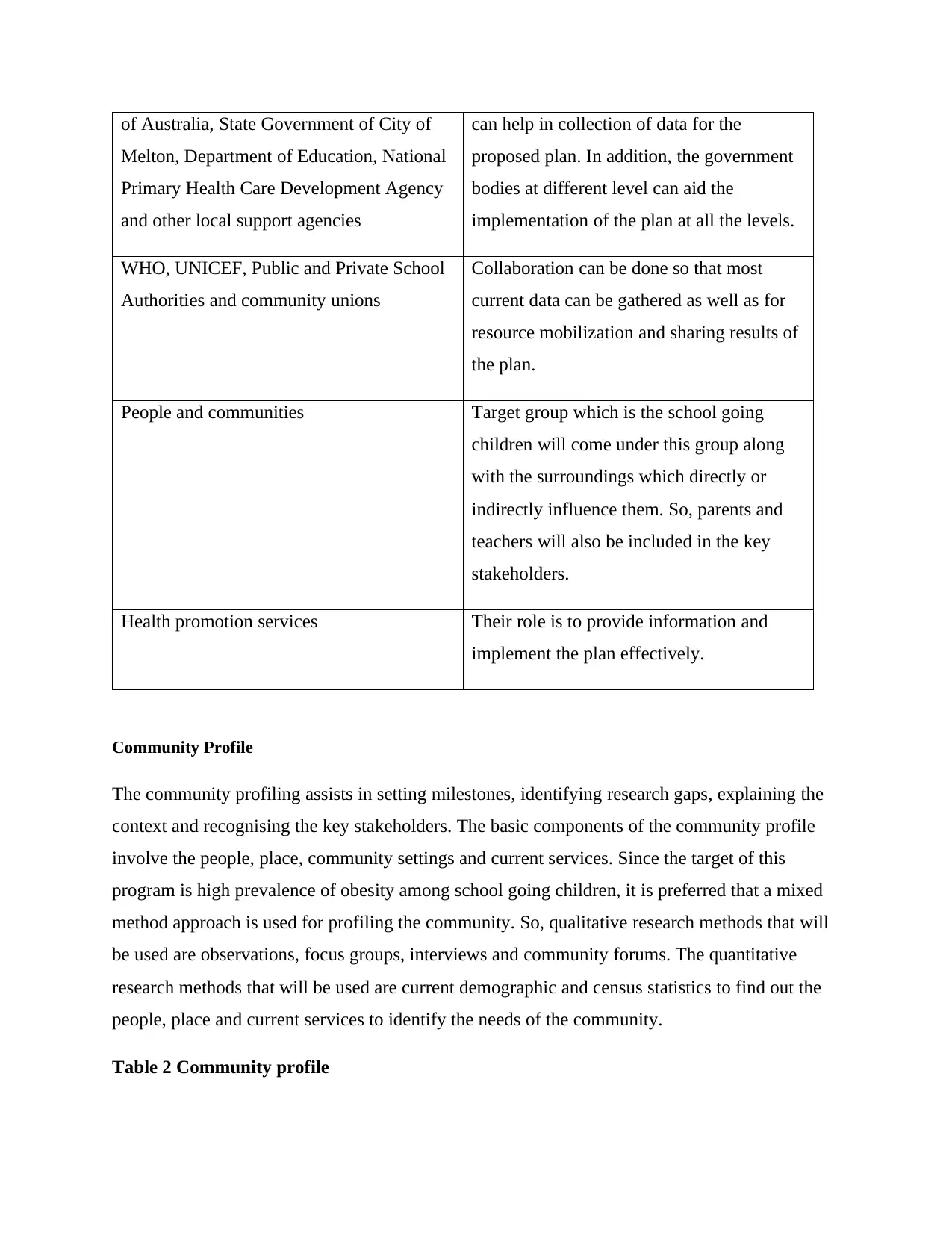
of Australia, State Government of City of
Melton, Department of Education, National
Primary Health Care Development Agency
and other local support agencies
can help in collection of data for the
proposed plan. In addition, the government
bodies at different level can aid the
implementation of the plan at all the levels.
WHO, UNICEF, Public and Private School
Authorities and community unions
Collaboration can be done so that most
current data can be gathered as well as for
resource mobilization and sharing results of
the plan.
People and communities Target group which is the school going
children will come under this group along
with the surroundings which directly or
indirectly influence them. So, parents and
teachers will also be included in the key
stakeholders.
Health promotion services Their role is to provide information and
implement the plan effectively.
Community Profile
The community profiling assists in setting milestones, identifying research gaps, explaining the
context and recognising the key stakeholders. The basic components of the community profile
involve the people, place, community settings and current services. Since the target of this
program is high prevalence of obesity among school going children, it is preferred that a mixed
method approach is used for profiling the community. So, qualitative research methods that will
be used are observations, focus groups, interviews and community forums. The quantitative
research methods that will be used are current demographic and census statistics to find out the
people, place and current services to identify the needs of the community.
Table 2 Community profile
Melton, Department of Education, National
Primary Health Care Development Agency
and other local support agencies
can help in collection of data for the
proposed plan. In addition, the government
bodies at different level can aid the
implementation of the plan at all the levels.
WHO, UNICEF, Public and Private School
Authorities and community unions
Collaboration can be done so that most
current data can be gathered as well as for
resource mobilization and sharing results of
the plan.
People and communities Target group which is the school going
children will come under this group along
with the surroundings which directly or
indirectly influence them. So, parents and
teachers will also be included in the key
stakeholders.
Health promotion services Their role is to provide information and
implement the plan effectively.
Community Profile
The community profiling assists in setting milestones, identifying research gaps, explaining the
context and recognising the key stakeholders. The basic components of the community profile
involve the people, place, community settings and current services. Since the target of this
program is high prevalence of obesity among school going children, it is preferred that a mixed
method approach is used for profiling the community. So, qualitative research methods that will
be used are observations, focus groups, interviews and community forums. The quantitative
research methods that will be used are current demographic and census statistics to find out the
people, place and current services to identify the needs of the community.
Table 2 Community profile
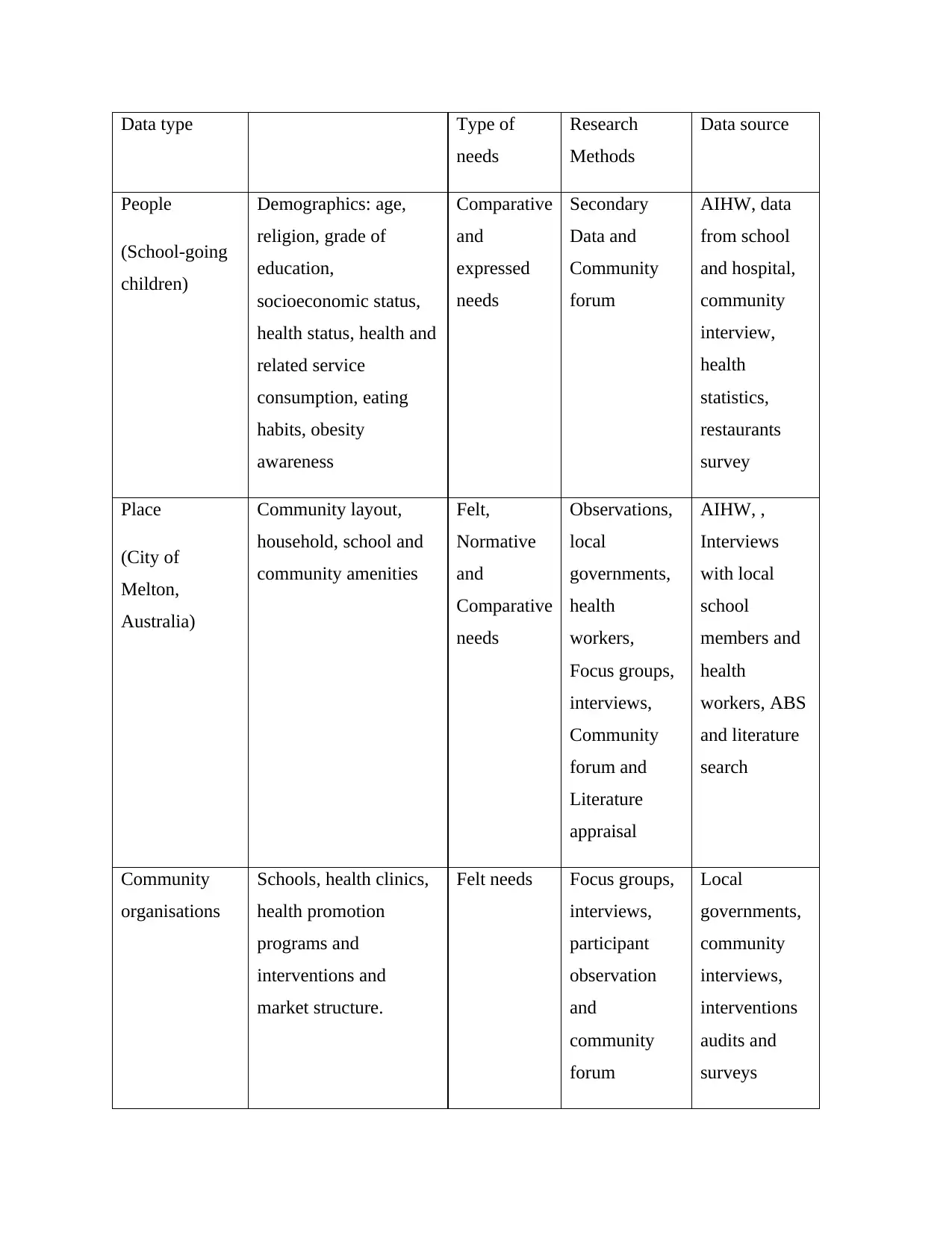
Data type Type of
needs
Research
Methods
Data source
People
(School-going
children)
Demographics: age,
religion, grade of
education,
socioeconomic status,
health status, health and
related service
consumption, eating
habits, obesity
awareness
Comparative
and
expressed
needs
Secondary
Data and
Community
forum
AIHW, data
from school
and hospital,
community
interview,
health
statistics,
restaurants
survey
Place
(City of
Melton,
Australia)
Community layout,
household, school and
community amenities
Felt,
Normative
and
Comparative
needs
Observations,
local
governments,
health
workers,
Focus groups,
interviews,
Community
forum and
Literature
appraisal
AIHW, ,
Interviews
with local
school
members and
health
workers, ABS
and literature
search
Community
organisations
Schools, health clinics,
health promotion
programs and
interventions and
market structure.
Felt needs Focus groups,
interviews,
participant
observation
and
community
forum
Local
governments,
community
interviews,
interventions
audits and
surveys
needs
Research
Methods
Data source
People
(School-going
children)
Demographics: age,
religion, grade of
education,
socioeconomic status,
health status, health and
related service
consumption, eating
habits, obesity
awareness
Comparative
and
expressed
needs
Secondary
Data and
Community
forum
AIHW, data
from school
and hospital,
community
interview,
health
statistics,
restaurants
survey
Place
(City of
Melton,
Australia)
Community layout,
household, school and
community amenities
Felt,
Normative
and
Comparative
needs
Observations,
local
governments,
health
workers,
Focus groups,
interviews,
Community
forum and
Literature
appraisal
AIHW, ,
Interviews
with local
school
members and
health
workers, ABS
and literature
search
Community
organisations
Schools, health clinics,
health promotion
programs and
interventions and
market structure.
Felt needs Focus groups,
interviews,
participant
observation
and
community
forum
Local
governments,
community
interviews,
interventions
audits and
surveys
⊘ This is a preview!⊘
Do you want full access?
Subscribe today to unlock all pages.

Trusted by 1+ million students worldwide
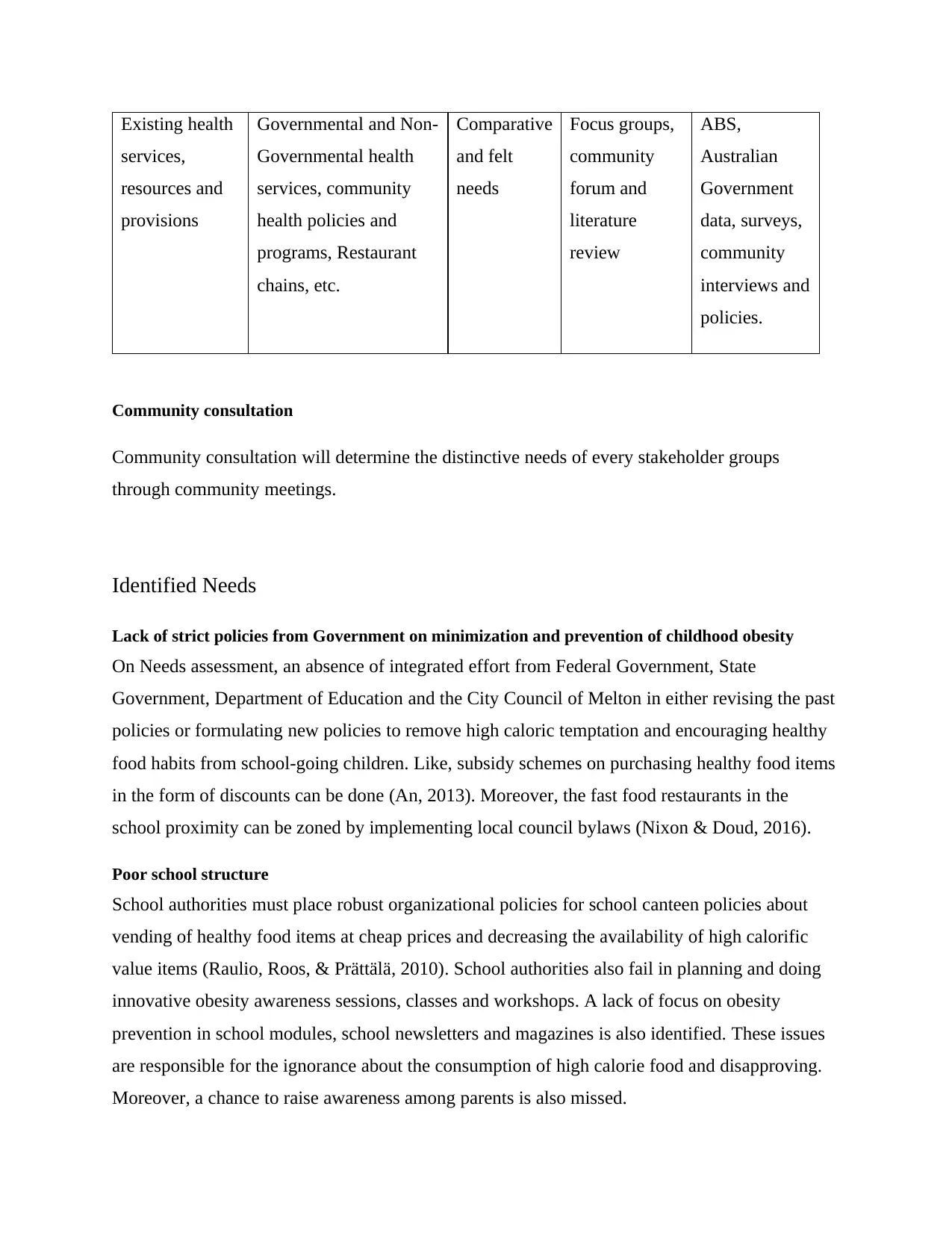
Existing health
services,
resources and
provisions
Governmental and Non-
Governmental health
services, community
health policies and
programs, Restaurant
chains, etc.
Comparative
and felt
needs
Focus groups,
community
forum and
literature
review
ABS,
Australian
Government
data, surveys,
community
interviews and
policies.
Community consultation
Community consultation will determine the distinctive needs of every stakeholder groups
through community meetings.
Identified Needs
Lack of strict policies from Government on minimization and prevention of childhood obesity
On Needs assessment, an absence of integrated effort from Federal Government, State
Government, Department of Education and the City Council of Melton in either revising the past
policies or formulating new policies to remove high caloric temptation and encouraging healthy
food habits from school-going children. Like, subsidy schemes on purchasing healthy food items
in the form of discounts can be done (An, 2013). Moreover, the fast food restaurants in the
school proximity can be zoned by implementing local council bylaws (Nixon & Doud, 2016).
Poor school structure
School authorities must place robust organizational policies for school canteen policies about
vending of healthy food items at cheap prices and decreasing the availability of high calorific
value items (Raulio, Roos, & Prättälä, 2010). School authorities also fail in planning and doing
innovative obesity awareness sessions, classes and workshops. A lack of focus on obesity
prevention in school modules, school newsletters and magazines is also identified. These issues
are responsible for the ignorance about the consumption of high calorie food and disapproving.
Moreover, a chance to raise awareness among parents is also missed.
services,
resources and
provisions
Governmental and Non-
Governmental health
services, community
health policies and
programs, Restaurant
chains, etc.
Comparative
and felt
needs
Focus groups,
community
forum and
literature
review
ABS,
Australian
Government
data, surveys,
community
interviews and
policies.
Community consultation
Community consultation will determine the distinctive needs of every stakeholder groups
through community meetings.
Identified Needs
Lack of strict policies from Government on minimization and prevention of childhood obesity
On Needs assessment, an absence of integrated effort from Federal Government, State
Government, Department of Education and the City Council of Melton in either revising the past
policies or formulating new policies to remove high caloric temptation and encouraging healthy
food habits from school-going children. Like, subsidy schemes on purchasing healthy food items
in the form of discounts can be done (An, 2013). Moreover, the fast food restaurants in the
school proximity can be zoned by implementing local council bylaws (Nixon & Doud, 2016).
Poor school structure
School authorities must place robust organizational policies for school canteen policies about
vending of healthy food items at cheap prices and decreasing the availability of high calorific
value items (Raulio, Roos, & Prättälä, 2010). School authorities also fail in planning and doing
innovative obesity awareness sessions, classes and workshops. A lack of focus on obesity
prevention in school modules, school newsletters and magazines is also identified. These issues
are responsible for the ignorance about the consumption of high calorie food and disapproving.
Moreover, a chance to raise awareness among parents is also missed.
Paraphrase This Document
Need a fresh take? Get an instant paraphrase of this document with our AI Paraphraser
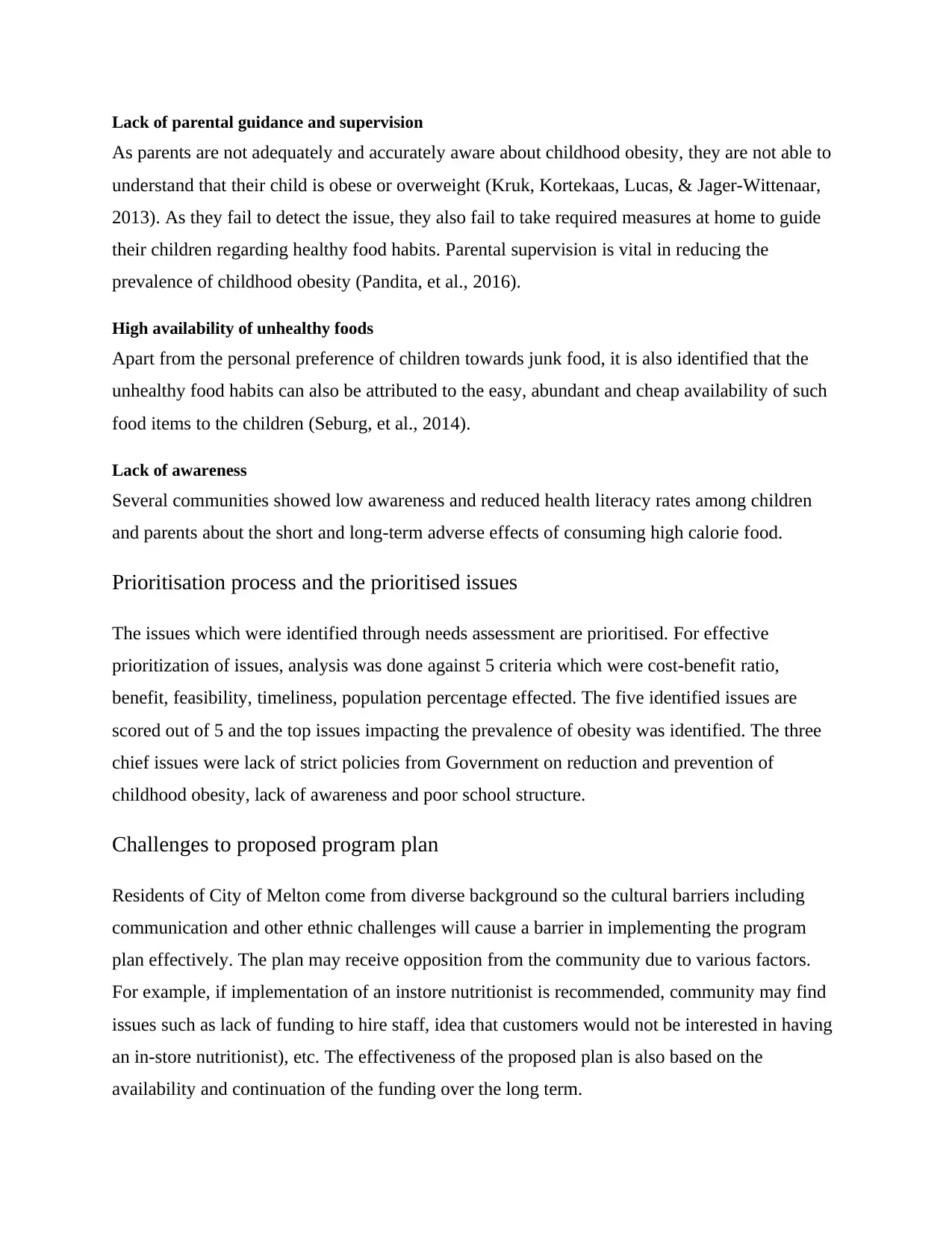
Lack of parental guidance and supervision
As parents are not adequately and accurately aware about childhood obesity, they are not able to
understand that their child is obese or overweight (Kruk, Kortekaas, Lucas, & Jager-Wittenaar,
2013). As they fail to detect the issue, they also fail to take required measures at home to guide
their children regarding healthy food habits. Parental supervision is vital in reducing the
prevalence of childhood obesity (Pandita, et al., 2016).
High availability of unhealthy foods
Apart from the personal preference of children towards junk food, it is also identified that the
unhealthy food habits can also be attributed to the easy, abundant and cheap availability of such
food items to the children (Seburg, et al., 2014).
Lack of awareness
Several communities showed low awareness and reduced health literacy rates among children
and parents about the short and long-term adverse effects of consuming high calorie food.
Prioritisation process and the prioritised issues
The issues which were identified through needs assessment are prioritised. For effective
prioritization of issues, analysis was done against 5 criteria which were cost-benefit ratio,
benefit, feasibility, timeliness, population percentage effected. The five identified issues are
scored out of 5 and the top issues impacting the prevalence of obesity was identified. The three
chief issues were lack of strict policies from Government on reduction and prevention of
childhood obesity, lack of awareness and poor school structure.
Challenges to proposed program plan
Residents of City of Melton come from diverse background so the cultural barriers including
communication and other ethnic challenges will cause a barrier in implementing the program
plan effectively. The plan may receive opposition from the community due to various factors.
For example, if implementation of an instore nutritionist is recommended, community may find
issues such as lack of funding to hire staff, idea that customers would not be interested in having
an in-store nutritionist), etc. The effectiveness of the proposed plan is also based on the
availability and continuation of the funding over the long term.
As parents are not adequately and accurately aware about childhood obesity, they are not able to
understand that their child is obese or overweight (Kruk, Kortekaas, Lucas, & Jager-Wittenaar,
2013). As they fail to detect the issue, they also fail to take required measures at home to guide
their children regarding healthy food habits. Parental supervision is vital in reducing the
prevalence of childhood obesity (Pandita, et al., 2016).
High availability of unhealthy foods
Apart from the personal preference of children towards junk food, it is also identified that the
unhealthy food habits can also be attributed to the easy, abundant and cheap availability of such
food items to the children (Seburg, et al., 2014).
Lack of awareness
Several communities showed low awareness and reduced health literacy rates among children
and parents about the short and long-term adverse effects of consuming high calorie food.
Prioritisation process and the prioritised issues
The issues which were identified through needs assessment are prioritised. For effective
prioritization of issues, analysis was done against 5 criteria which were cost-benefit ratio,
benefit, feasibility, timeliness, population percentage effected. The five identified issues are
scored out of 5 and the top issues impacting the prevalence of obesity was identified. The three
chief issues were lack of strict policies from Government on reduction and prevention of
childhood obesity, lack of awareness and poor school structure.
Challenges to proposed program plan
Residents of City of Melton come from diverse background so the cultural barriers including
communication and other ethnic challenges will cause a barrier in implementing the program
plan effectively. The plan may receive opposition from the community due to various factors.
For example, if implementation of an instore nutritionist is recommended, community may find
issues such as lack of funding to hire staff, idea that customers would not be interested in having
an in-store nutritionist), etc. The effectiveness of the proposed plan is also based on the
availability and continuation of the funding over the long term.
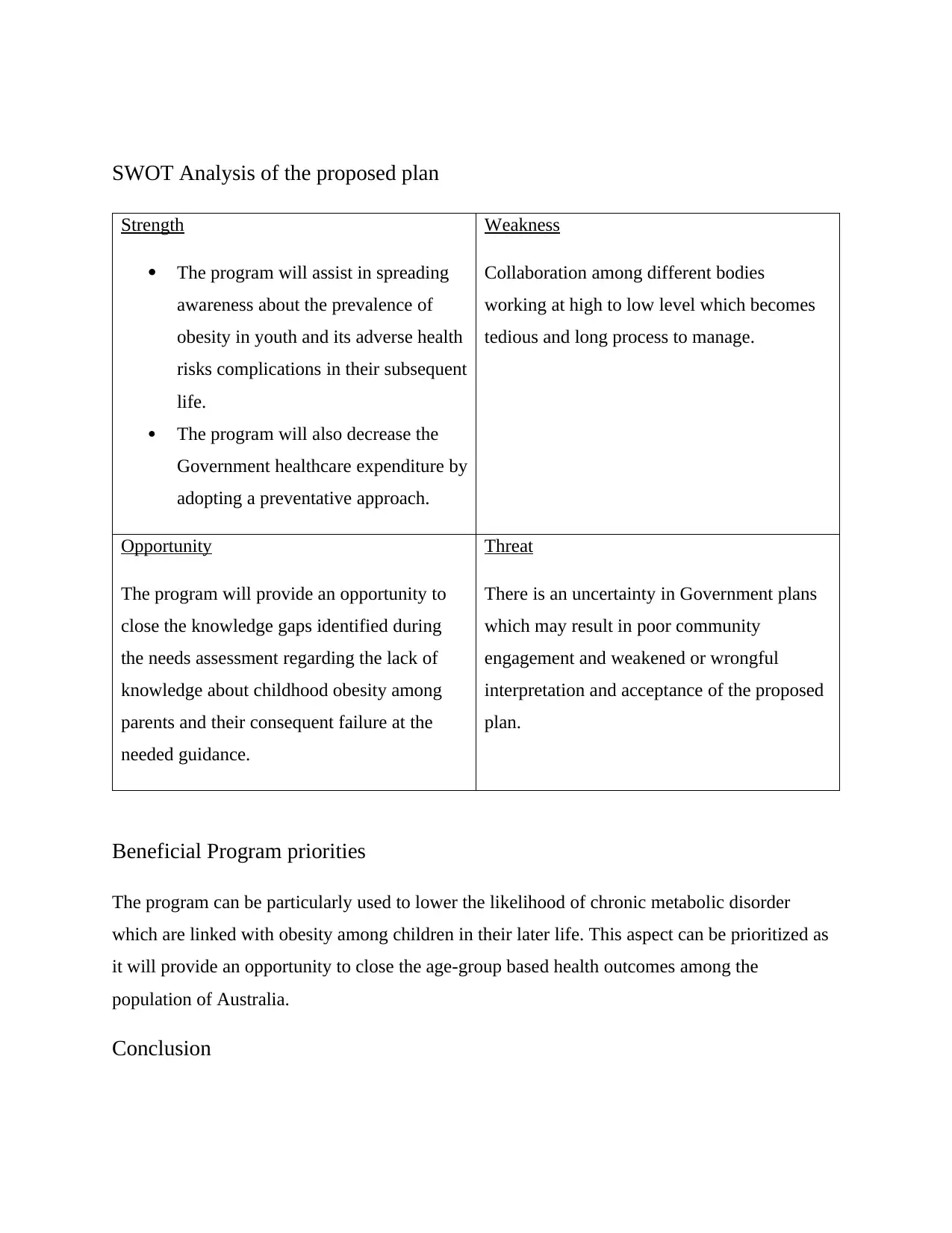
SWOT Analysis of the proposed plan
Strength
The program will assist in spreading
awareness about the prevalence of
obesity in youth and its adverse health
risks complications in their subsequent
life.
The program will also decrease the
Government healthcare expenditure by
adopting a preventative approach.
Weakness
Collaboration among different bodies
working at high to low level which becomes
tedious and long process to manage.
Opportunity
The program will provide an opportunity to
close the knowledge gaps identified during
the needs assessment regarding the lack of
knowledge about childhood obesity among
parents and their consequent failure at the
needed guidance.
Threat
There is an uncertainty in Government plans
which may result in poor community
engagement and weakened or wrongful
interpretation and acceptance of the proposed
plan.
Beneficial Program priorities
The program can be particularly used to lower the likelihood of chronic metabolic disorder
which are linked with obesity among children in their later life. This aspect can be prioritized as
it will provide an opportunity to close the age-group based health outcomes among the
population of Australia.
Conclusion
Strength
The program will assist in spreading
awareness about the prevalence of
obesity in youth and its adverse health
risks complications in their subsequent
life.
The program will also decrease the
Government healthcare expenditure by
adopting a preventative approach.
Weakness
Collaboration among different bodies
working at high to low level which becomes
tedious and long process to manage.
Opportunity
The program will provide an opportunity to
close the knowledge gaps identified during
the needs assessment regarding the lack of
knowledge about childhood obesity among
parents and their consequent failure at the
needed guidance.
Threat
There is an uncertainty in Government plans
which may result in poor community
engagement and weakened or wrongful
interpretation and acceptance of the proposed
plan.
Beneficial Program priorities
The program can be particularly used to lower the likelihood of chronic metabolic disorder
which are linked with obesity among children in their later life. This aspect can be prioritized as
it will provide an opportunity to close the age-group based health outcomes among the
population of Australia.
Conclusion
⊘ This is a preview!⊘
Do you want full access?
Subscribe today to unlock all pages.

Trusted by 1+ million students worldwide
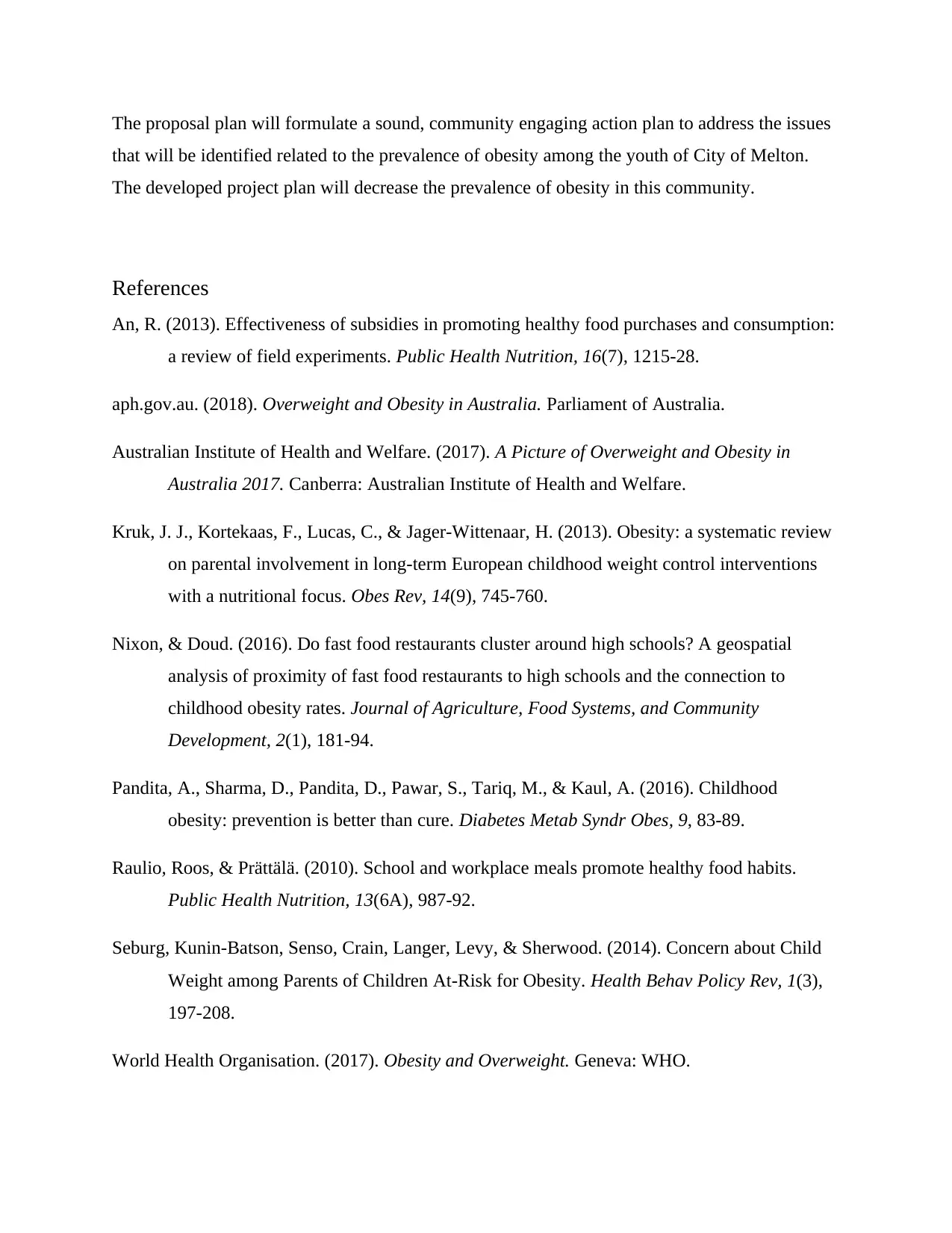
The proposal plan will formulate a sound, community engaging action plan to address the issues
that will be identified related to the prevalence of obesity among the youth of City of Melton.
The developed project plan will decrease the prevalence of obesity in this community.
References
An, R. (2013). Effectiveness of subsidies in promoting healthy food purchases and consumption:
a review of field experiments. Public Health Nutrition, 16(7), 1215-28.
aph.gov.au. (2018). Overweight and Obesity in Australia. Parliament of Australia.
Australian Institute of Health and Welfare. (2017). A Picture of Overweight and Obesity in
Australia 2017. Canberra: Australian Institute of Health and Welfare.
Kruk, J. J., Kortekaas, F., Lucas, C., & Jager-Wittenaar, H. (2013). Obesity: a systematic review
on parental involvement in long-term European childhood weight control interventions
with a nutritional focus. Obes Rev, 14(9), 745-760.
Nixon, & Doud. (2016). Do fast food restaurants cluster around high schools? A geospatial
analysis of proximity of fast food restaurants to high schools and the connection to
childhood obesity rates. Journal of Agriculture, Food Systems, and Community
Development, 2(1), 181-94.
Pandita, A., Sharma, D., Pandita, D., Pawar, S., Tariq, M., & Kaul, A. (2016). Childhood
obesity: prevention is better than cure. Diabetes Metab Syndr Obes, 9, 83-89.
Raulio, Roos, & Prättälä. (2010). School and workplace meals promote healthy food habits.
Public Health Nutrition, 13(6A), 987-92.
Seburg, Kunin-Batson, Senso, Crain, Langer, Levy, & Sherwood. (2014). Concern about Child
Weight among Parents of Children At-Risk for Obesity. Health Behav Policy Rev, 1(3),
197-208.
World Health Organisation. (2017). Obesity and Overweight. Geneva: WHO.
that will be identified related to the prevalence of obesity among the youth of City of Melton.
The developed project plan will decrease the prevalence of obesity in this community.
References
An, R. (2013). Effectiveness of subsidies in promoting healthy food purchases and consumption:
a review of field experiments. Public Health Nutrition, 16(7), 1215-28.
aph.gov.au. (2018). Overweight and Obesity in Australia. Parliament of Australia.
Australian Institute of Health and Welfare. (2017). A Picture of Overweight and Obesity in
Australia 2017. Canberra: Australian Institute of Health and Welfare.
Kruk, J. J., Kortekaas, F., Lucas, C., & Jager-Wittenaar, H. (2013). Obesity: a systematic review
on parental involvement in long-term European childhood weight control interventions
with a nutritional focus. Obes Rev, 14(9), 745-760.
Nixon, & Doud. (2016). Do fast food restaurants cluster around high schools? A geospatial
analysis of proximity of fast food restaurants to high schools and the connection to
childhood obesity rates. Journal of Agriculture, Food Systems, and Community
Development, 2(1), 181-94.
Pandita, A., Sharma, D., Pandita, D., Pawar, S., Tariq, M., & Kaul, A. (2016). Childhood
obesity: prevention is better than cure. Diabetes Metab Syndr Obes, 9, 83-89.
Raulio, Roos, & Prättälä. (2010). School and workplace meals promote healthy food habits.
Public Health Nutrition, 13(6A), 987-92.
Seburg, Kunin-Batson, Senso, Crain, Langer, Levy, & Sherwood. (2014). Concern about Child
Weight among Parents of Children At-Risk for Obesity. Health Behav Policy Rev, 1(3),
197-208.
World Health Organisation. (2017). Obesity and Overweight. Geneva: WHO.
Paraphrase This Document
Need a fresh take? Get an instant paraphrase of this document with our AI Paraphraser

1 out of 8
Related Documents
Your All-in-One AI-Powered Toolkit for Academic Success.
+13062052269
info@desklib.com
Available 24*7 on WhatsApp / Email
![[object Object]](/_next/static/media/star-bottom.7253800d.svg)
Unlock your academic potential
Copyright © 2020–2025 A2Z Services. All Rights Reserved. Developed and managed by ZUCOL.





